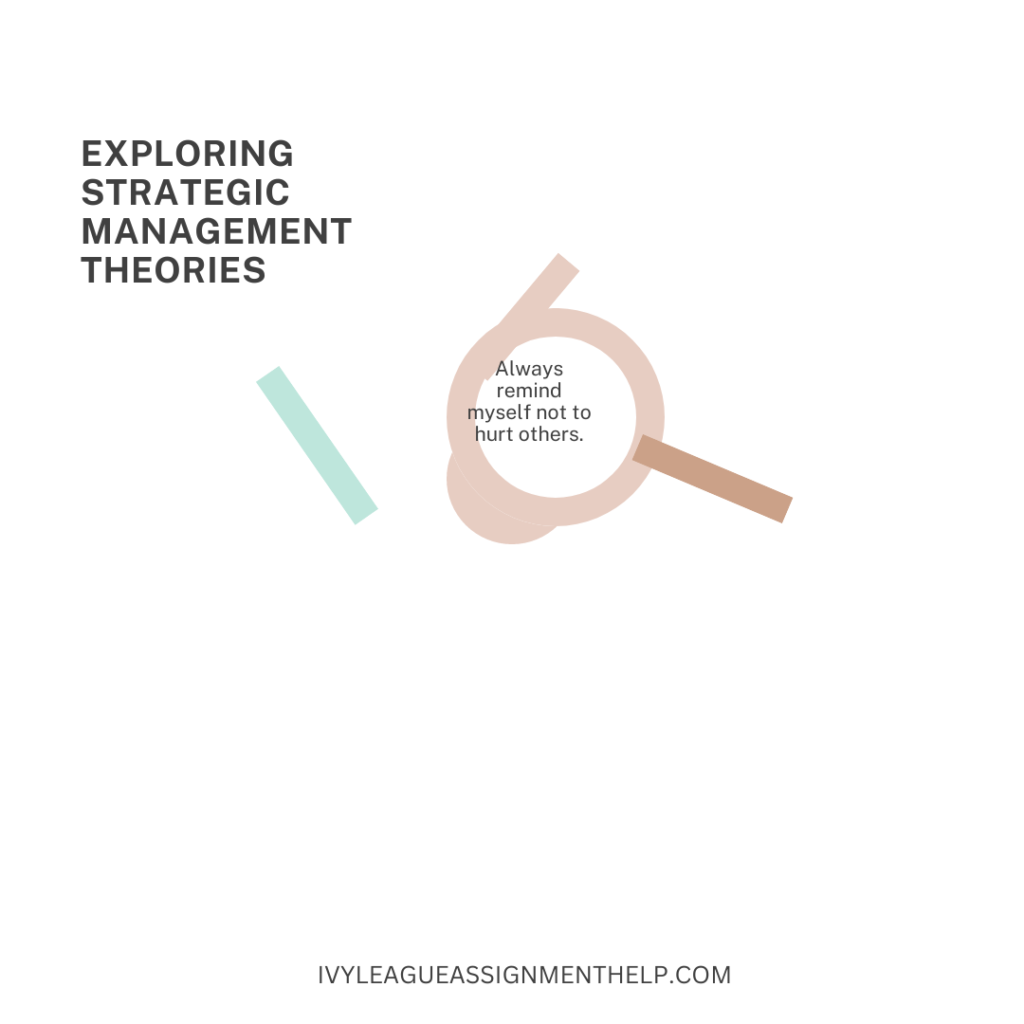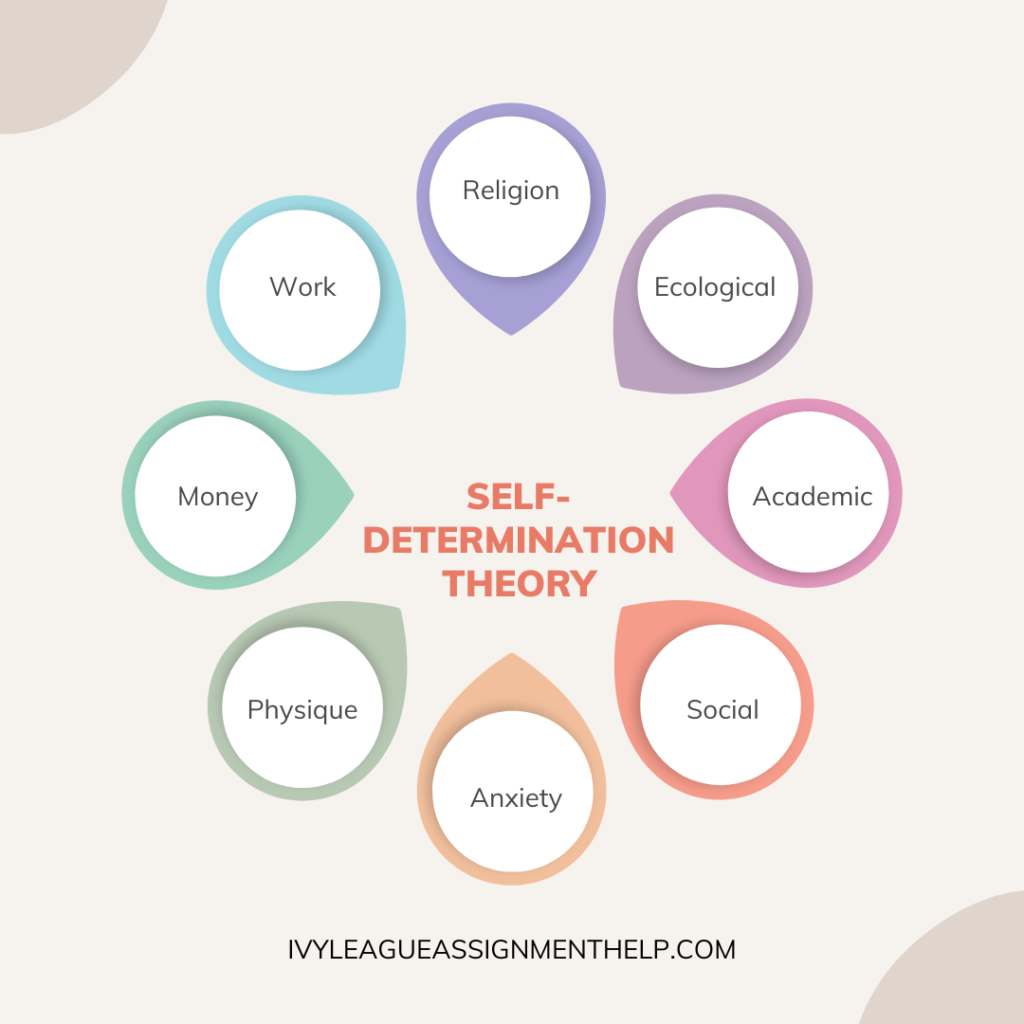Introduction to Strategic Management Theories
Strategic management theories provide frameworks and tools to help organizations navigate complex business environments, achieve competitive advantage, and sustain long-term success. These theories have evolved over time, reflecting changes in market dynamics, technological advancements, and shifts in consumer behavior. At ivyleagueassignmenthelp.com we help and guide students to understanding how applying strategic management theories is crucial for effective planning, decision-making, and execution of business strategies.

Overview of Key Strategic Management Theories
Several foundational theories have shaped the field of strategic management, each offering unique perspectives and methodologies.
Porter’s Five Forces
Michael Porter’s Five Forces framework analyzes the competitive forces within an industry to determine its attractiveness and profitability. The five forces include competitive rivalry, threat of new entrants, bargaining power of suppliers, bargaining power of buyers, and threat of substitutes.
Resource-Based View (RBV)
The Resource-Based View (RBV) focuses on internal resources and capabilities as the primary sources of competitive advantage. This theory emphasizes the importance of identifying, developing, and leveraging unique resources that are valuable, rare, inimitable, and organized.
SWOT Analysis
SWOT Analysis is a strategic planning tool that identifies an organization’s strengths, weaknesses, opportunities, and threats. This framework helps businesses assess their internal capabilities and external environment to formulate effective strategies.
Balanced Scorecard
The Balanced Scorecard, developed by Robert Kaplan and David Norton, is a performance management tool that integrates financial and non-financial measures. It evaluates an organization from four perspectives: financial, customer, internal processes, and learning and growth.
Blue Ocean Strategy
Blue Ocean Strategy, introduced by W. Chan Kim and Renée Mauborgne, focuses on creating uncontested market space and making competition irrelevant. It emphasizes value innovation by simultaneously pursuing differentiation and low cost.
Ansoff Matrix
The Ansoff Matrix, developed by Igor Ansoff, is a strategic planning tool used to identify growth opportunities. It outlines four growth strategies: market penetration, market development, product development, and diversification.
PESTLE Analysis
PESTLE Analysis examines the external macro-environmental factors affecting an organization. These factors include Political, Economic, Social, Technological, Legal, and Environmental influences.
Theoretical Frameworks of Strategic Management
Strategic management theories are grounded in concepts of competitive advantage, strategic planning, and environmental scanning.
Competitive Advantage
Competitive advantage refers to the attributes that allow an organization to outperform its competitors. Strategic management theories focus on identifying and sustaining these advantages through various methods, including resource optimization, market positioning, and innovation.
Strategic Planning
Strategic planning involves defining the organization’s direction, setting goals, and outlining the actions needed to achieve these goals. Effective strategic planning requires a thorough understanding of both internal capabilities and external conditions.
Environmental Scanning
Environmental scanning is the process of analyzing external factors that can impact an organization’s strategy. This includes monitoring economic trends, technological advancements, regulatory changes, and competitive dynamics.
Porter’s Five Forces
Porter’s Five Forces framework is a tool for analyzing the competitive forces within an industry.
Industry Analysis
Industry analysis involves examining the intensity of competitive rivalry, the threat of new entrants, the bargaining power of suppliers and buyers, and the threat of substitutes. Understanding these forces helps organizations develop strategies to enhance their competitive position.
Application in Competitive Strategy
Applying Porter’s Five Forces enables businesses to identify strategic opportunities and threats, assess industry attractiveness, and make informed decisions about market entry, expansion, or diversification.
Resource-Based View (RBV)
The Resource-Based View (RBV) emphasizes the importance of internal resources and capabilities.
Internal Resources and Capabilities
RBV focuses on identifying resources that are valuable, rare, difficult to imitate, and well-organized. These resources can include tangible assets, intangible assets, and human capital.
Achieving Sustainable Competitive Advantage
Sustainable competitive advantage is achieved by effectively leveraging unique resources and capabilities. This involves continuous investment in innovation, skill development, and resource optimization.
SWOT Analysis
SWOT Analysis is a comprehensive tool for strategic planning.
Strengths
Strengths are internal attributes that give an organization a competitive edge, such as strong brand reputation, advanced technology, or skilled workforce.
Weaknesses
Weaknesses are internal factors that hinder organizational performance, such as limited resources, outdated technology, or poor management practices.
Opportunities
Opportunities are external factors that an organization can capitalize on, such as emerging markets, technological advancements, or changes in consumer preferences.
Threats
Threats are external challenges that can negatively impact an organization, such as economic downturns, increased competition, or regulatory changes.
Balanced Scorecard
The Balanced Scorecard integrates financial and non-financial performance measures.
Financial Perspective
The financial perspective focuses on traditional financial metrics, such as revenue growth, profitability, and return on investment.
Customer Perspective
The customer perspective evaluates customer satisfaction, retention, and market share. It emphasizes understanding and meeting customer needs.
Internal Process Perspective
The internal process perspective assesses the efficiency and effectiveness of internal operations. It focuses on process improvement, quality control, and operational excellence.
Learning and Growth Perspective
The learning and growth perspective measures the organization’s ability to innovate, learn, and grow. It includes metrics related to employee development, organizational culture, and knowledge management.
Blue Ocean Strategy
Blue Ocean Strategy focuses on creating new market space.
Creating Uncontested Market Space
This strategy involves identifying untapped markets and developing innovative offerings that differentiate the organization from competitors.
Value Innovation
Value innovation is the cornerstone of Blue Ocean Strategy. It involves creating products or services that offer superior value while reducing costs, thus making competition irrelevant.
Ansoff Matrix
The Ansoff Matrix helps organizations identify growth opportunities.
Market Penetration
Market penetration involves increasing market share in existing markets through strategies like price reduction, increased marketing, or product improvements.
Market Development
Market development focuses on entering new markets with existing products. This can involve geographic expansion or targeting new customer segments.
Product Development
Product development involves creating new products for existing markets. This strategy emphasizes innovation and product diversification.
Diversification
Diversification involves entering new markets with new products. This high-risk strategy can be related (similar to existing products) or unrelated (entirely new industries).
PESTLE Analysis
PESTLE Analysis examines external macro-environmental factors.
Political
Political factors include government policies, regulations, and political stability. These factors can impact business operations and strategy.
Economic
Economic factors include economic growth, inflation rates, exchange rates, and unemployment levels. These factors influence consumer spending and business performance.
Social
Social factors include demographics, cultural trends, and societal values. These factors affect consumer behavior and market demand.
Technological
Technological factors include technological advancements, innovation rates, and the adoption of new technologies. These factors can create opportunities and threats for businesses.
Legal
Legal factors include laws and regulations related to employment, health and safety, and intellectual property. Compliance with legal requirements is crucial for business operations.
Environmental
Environmental factors include ecological and environmental aspects such as climate change, sustainability, and environmental regulations. These factors can affect business practices and consumer preferences.
Applying Strategic Management Theories in Business
Implementing strategic management theories enhances planning and decision-making processes.
Enhancing Strategic Planning
Strategic management theories provide tools and frameworks for comprehensive analysis, helping businesses develop effective strategic plans.
Improving Decision-Making Processes
By integrating insights from various theories, managers can make more informed decisions that align with organizational goals and adapt to changing environments.
Strategies for Managers to Apply Strategic Management Theories
| Theory | Key Strategies |
|---|---|
| Porter’s Five Forces | Conduct industry analysis, assess competitive forces, develop competitive strategies. |
| Resource-Based View (RBV) | Identify and leverage unique resources, invest in capabilities, sustain competitive advantage. |
| SWOT Analysis | Conduct internal and external analysis, identify strategic priorities, align resources. |
| Balanced Scorecard | Integrate financial and non-financial metrics, align performance measures with strategy. |
| Blue Ocean Strategy | Identify untapped markets, innovate to create value, differentiate offerings. |
| Ansoff Matrix | Explore growth opportunities, develop market and product strategies, assess risk. |
| PESTLE Analysis | Monitor macro-environmental factors, anticipate changes, adapt strategies accordingly. |
Benefits of Using Strategic Management Theories
Applying strategic management theories offers several benefits for organizations.
Enhanced Competitive Position
Strategic management theories help organizations identify and leverage competitive advantages, enhancing their position in the market.
Improved Organizational Performance
Effective strategic planning and execution lead to improved operational efficiency, higher profitability, and better overall performance.
Better Risk Management
Strategic management theories provide tools for identifying and mitigating risks, helping organizations navigate uncertainties and adapt to changes.
Challenges and Criticisms of Strategic Management Theories
Despite their benefits, strategic management theories face certain challenges and criticisms.
Limitations
One limitation is that these theories may not account for the unique contexts and complexities of every organization. Additionally, implementing strategic management frameworks can require significant time and resources.
Common Misconceptions
A common misconception is that strategic management theories guarantee success. In reality, their effectiveness depends on various factors, including leadership, organizational culture, and market conditions.
Comparing Strategic Management Theories
Different strategic management theories offer unique strengths and can be applied based on situational needs.
Strengths and Weaknesses
Each theory has its strengths and weaknesses. For example, Porter’s Five Forces provides a comprehensive industry analysis, while RBV focuses on internal resources. SWOT Analysis is straightforward but may oversimplify complexities, and the Balanced Scorecard integrates multiple performance metrics but requires careful alignment.
Situational Applications
Choosing the right theory depends on the specific context and goals of the strategic initiative. Managers may combine elements from different theories to address their unique challenges and opportunities.
Future Directions in Strategic Management Research
Research on strategic management continues to evolve, exploring new dimensions and applications.
Emerging Trends
Current research is examining the impact of digital transformation, globalization, and sustainability on strategic management practices.
Potential Developments
Future studies may explore the integration of strategic management theories with emerging technologies and their application across different industries and sectors.
FAQs on Strategic Management Theories
What are Strategic Management Theories?
Strategic management theories are frameworks and tools that help organizations navigate complex business environments, achieve competitive advantage, and sustain long-term success.
How can businesses apply Strategic Management Theories?
Businesses can apply strategic management theories by conducting comprehensive analyses, aligning resources with strategy, and implementing and monitoring strategies effectively.
What are the key components of Porter’s Five Forces?
The key components are competitive rivalry, threat of new entrants, bargaining power of suppliers, bargaining power of buyers, and threat of substitutes.
How do Strategic Management Theories compare with each other?
Strategic management theories vary in their approach and focus. For example, Porter’s Five Forces focuses on industry analysis, RBV emphasizes internal resources, and SWOT Analysis integrates internal and external factors.
What are the limitations of Strategic Management Theories?
Limitations include potential oversimplification of complex situations, the need for significant time and resources to implement frameworks, and dependency on factors such as leadership and organizational culture.
How do Strategic Management Theories improve organizational performance?
Strategic management theories improve performance by providing tools for comprehensive analysis, informed decision-making, and effective execution of strategies, leading to enhanced competitive position, operational efficiency, and profitability.
Conclusion
Strategic management theories provide valuable frameworks for guiding organizations through complex business environments. By understanding and applying these theories, managers can enhance strategic planning, improve decision-making processes, and achieve long-term success.


